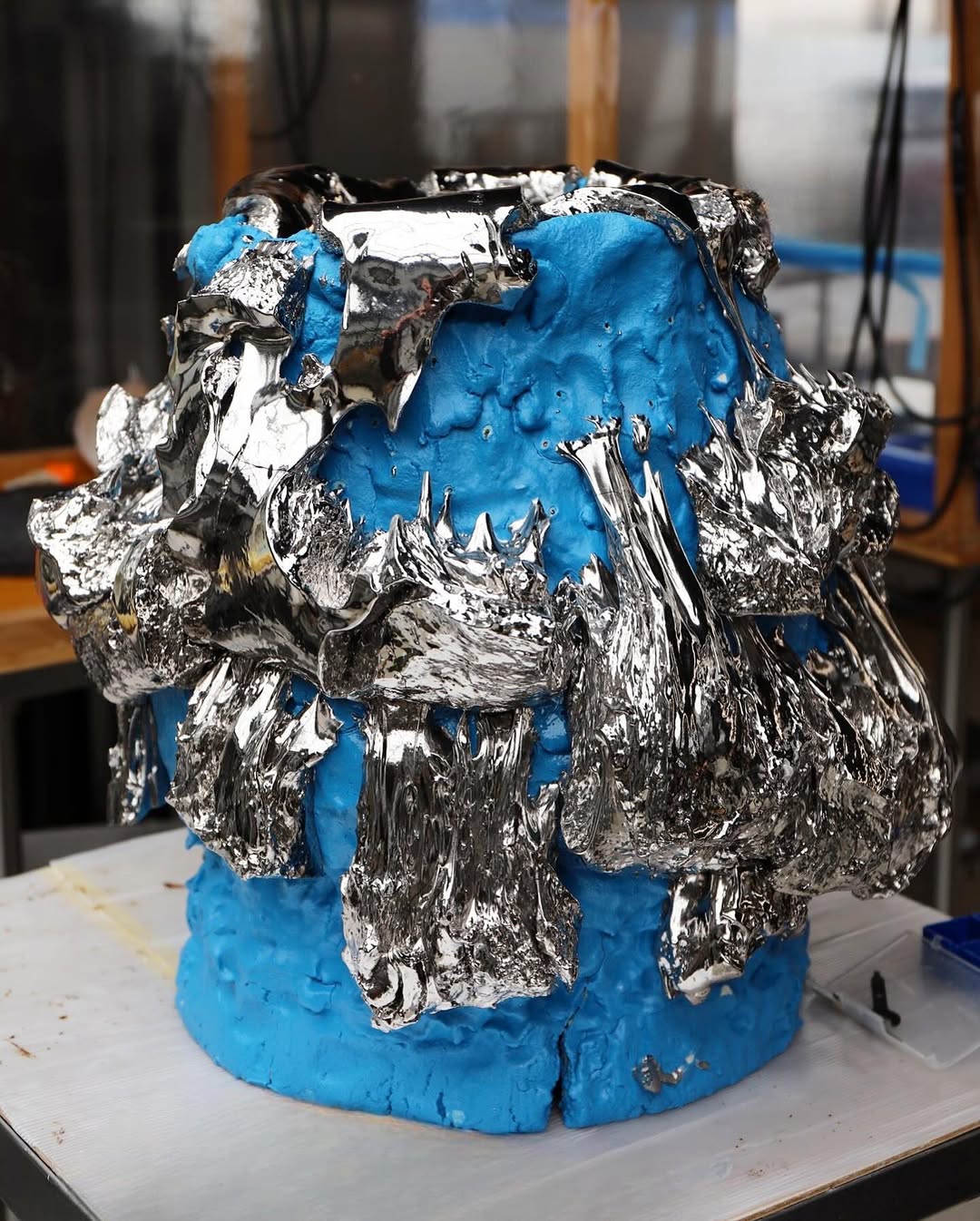Takuro Kuwata’s Ceramics Reimagine Wabi-Sabi in Technicolour
By Keshav Anand
Born in Japan’s Hiroshima Prefecture in 1981, Takuro Kuwata has earned a reputation for pushing the boundaries of ceramics, blending traditional Japanese techniques with modern experimentation for nearly two decades. Opening on 10 January 2025, New York gallery Salon 94 will present an exhibition of new works by the Japanese artist, showcasing his largest body of work in the city to date. His latest large-scale metallic tea bowls and sculptural pieces, created in his Gifu studio, continue to explore the wabi-sabi aesthetic of “flawed beauty” through vibrant colours, fractured forms, and glistening embellishments. In conversation with the artist, SC’s Keshav Anand delves into Kuwata’s inspirations and process. The artist’s words have been translated from Japanese to English.

Keshav Anand: What initially drew you to working with clay?
Takuro Kuwata: 始めたのは大学で陶芸に出会ったことがきっかけですが、今も続けているのは出会ったタイミングや環境が大きいと考えています。
I first encountered ceramics during my time at art university. I believe the timing and environment played a significant role in why I’ve continued with it to this day.
KA: Your upcoming exhibition at Salon 94 marks your largest in New York to date. Could you expand on the thinking behind the works included in this presentation?
TK: 初めてニューヨークで個展をしたのが、2013年の1月でした。約10年が経ちますがずっとその間もセラミックという素材を表現方法としてきました。手のひらに乗せれる作品から人力では動かせない作品。器型もあれば立体作品も、表現する場所も様々でしたが、ずっとセラミックで制作してきました。それを自分なりに踏まえた今の展示になります。
My first solo exhibition in New York took place in January 2013. Over the past decade, I’ve consistently used ceramics as my medium to express my vision. My creations have ranged from small, hand-sized pieces to large-scale works that are difficult to move by humans, covering everything from bowl shapes to sculptural forms. While the spaces showcasing my work have varied, ceramics have always been at the centre. This upcoming exhibition will reflect the journey and evolution of my work over the last ten years.

KA: You often emphasise the beauty of imperfections, drawing from the philosophy of wabi-sabi—how does this perspective shape your artistic process?
TK: 侘び寂びを感じたのは弟子入りして自然に体にしみついていった感覚になりますが、そこからの広がりで、ものを見る目線が変わった気がしています。侘び寂びという美意識が数百年前に生まれ、それを知るきっかけやタイミングがあり、それに気づいたことで自分の制作の中で意図的に侘び寂びを意識する様になると同時にその数百年前の考えを今に置き換えて表現したくなったということがプロセスになります。
When I was young, spending time in the studio of the ceramics master [Susumu Zaima], I gradually and naturally began to understand the essence of wabi-sabi. Over time, this sense grew within me, offering a new perspective on how I perceive the world. Rooted in a philosophy of aesthetics that emerged hundreds of years ago, wabi-sabi deeply resonated with me. I came to recognise and feel its influence, and I began to intentionally incorporate it into my work. However, in the present day, the concept of wabi-sabi is evolving, and I felt compelled to explore my own way of expressing its essence.
KA: How do you decide when a piece is finished?
TK: わたしが経験の中で感じる良いと思うタイミングです。
When I feel it’s good, in my experience.

KA: Colour plays a significant role in your ceramics—how do you choose the bold and often unconventional palettes you employ?
TK: わたしは戦後の日本に生まれ、青春時代は西洋の音楽やファッションが好きで憧れを感じ時間を過ごしてきました。主観ですが、その中には、侘び寂びでは見ないカラフルで大胆な配色がありました。それを侘び寂びに持ち込みたくなりました。
I was born in Japan in the decades following the post-war period. As a child, I admired Western culture, particularly its music and fashion. Reflecting on this, I noticed the vibrant and bold colour combinations prevalent in Western culture, which are quite different from the subdued tones of wabi-sabi. This led me to wonder what it might look like to incorporate these vivid colours into the world of wabi-sabi.
KA: I’m curious to learn more about how living in the Mino region of Gifu Prefecture has influenced your output, particularly in regards to the materials you work with.
TK: わたしのスタジオがあるエリアは粘土などの原料が採掘される古くからの陶磁器の産地です。古くは侘び寂びからなる茶の湯の道具もこのエリアで作られていました。また産業としての陶磁器ではこのエリアが日本1の生産量を誇ります。それもあり多くの量と種類の原料が輸入されるとともに、生産技術の蓄積もあります。その豊かな環境に恩恵をうけながら、このタイミングで何を制作していく事が相応しいかを考えています。
My studio is situated in a region renowned for its long-standing tradition of ceramic production, known for its rich soil. Historically, this area produced wabi-sabi style tea ceremony bowls and utensils. Mino, in fact, is the leading region in Japan for ceramic production in terms of volume. The area boasts excellent infrastructure for ceramics, offering a wealth of knowledge, materials, techniques, and a supportive environment. I am fortunate to benefit from these resources.

KA: What is your favourite smell?
TK: シチュエーションによって変わるので1番は難しいです。夕方に近所から食事の匂いがするとそれは素敵ですし、香水のような高貴なかおりも好きです。
It depends on the situation, so it is hard to decide on just one. However, I think the smell of the food someone is cooking in the neighbourhood is pretty nice. At the same time, I like the elegant smell of a good perfume.
KA: And what are you currently reading?
TK: 今本は読んでいません。幼い頃から本を読むことは苦手でした。その分文字がないものを見る事が多いかもしれません。
I don’t read books much. I have not been good at reading since childhood. Instead, I like to look at more visual things.
Feature image: Takuro Kuwata, Chawan, 2024. Courtesy Takuro Kuwata and Salon 94